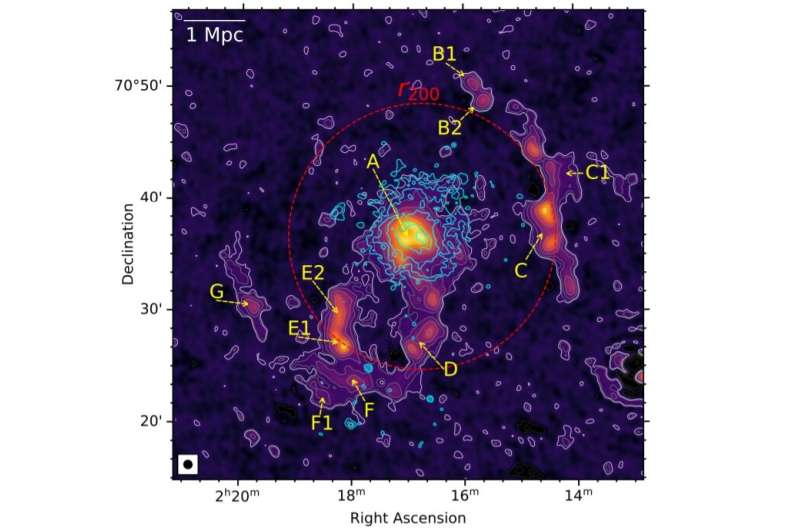June 14, 2021 report
Radio sources in the galaxy cluster ClG 0217+70 inspected by astronomers

Using the LOw Frequency ARray (LOFAR) and the Very Large Array (VLA), astronomers have conducted radio observations of a galaxy cluster known as ClG 0217+70 and obtained important information regarding giant radio sources in this cluster; one of them appears to be the most extended radio relic so far identified. The finding is reported in a paper published June 1 on arXiv.org.
Radio relics are diffuse, elongated radio sources of synchrotron origin. They occur in the form of spectacular single or double symmetric arcs at the peripheries of galaxy clusters. Astronomers are especially interested in searching for such sources in merging galaxy clusters as the number of radio relics associated with merger shocks is still small.
At a redshift of about 0.18, ClG 0217+70 is a merging galaxy cluster with an estimated mass of around 1.06 quadrillion solar masses. Previous observations of ClG 0217+70 have suggested that it hosts multiple radio-diffuse sources, including a radio halo, double relics on opposite sides, and internal filaments.
Now, a team of astronomers led by Duy Hoang of the University of Hamburg, Germany, has confirmed the presence of such features in ClG 0217+70, including a giant radio relic. Based on the data from LOFAR at 141 MHz and VLA at 1.5 GHz, and also archival datasets from VLA at 1.4 GHz, the researchers managed to obtain important information regarding the properties of these sources.
"In this paper, we present LOFAR 120–168 MHz observations of ClG 0217+70 to study the diffuse radio emission from the cluster at low frequencies. We combined the LOFAR data with the VLA L-band C- and D-array archival data to examine the spectral properties of these sources," the astronomers explained.
The data from LOFAR and VLA confirmed the presence of a giant radio halo in the center of ClG 0217+70 and multiple relics in its outskirts. The radio halo has a projected size of about 5.87 million light years, flux density at 141 MHz at a level of 623.6 mJy, which corresponds to a radio power of approximately 56.9 YW/Hz.
The study found that two of the identified radio relics in ClG 0217+70 are connected and likely belong to the same source estimated to have a size of about 11.4 million light years. This structure is therefore the largest radio relic known to date. The astronomers suppose that one other radio source could be part of this relic; however, further observations are needed to confirm this.
The research also found that the non-thermal radio and thermal X-ray emission in the halo region are positively correlated. The results suggest that the non-thermal components at high frequencies (1.4 GHz) decline more slowly than those at low frequencies (141 MHz). The astronomers concluded that there may be additional non-thermal processes in the outer regions of the halo as found in the X-ray data.
More information: A 3.5 Mpc-long radio relic in the galaxy cluster ClG 0217+70, arXiv:2106.00679 [astro-ph.HE] arxiv.org/abs/2106.00679
© 2021 Science X Network





















